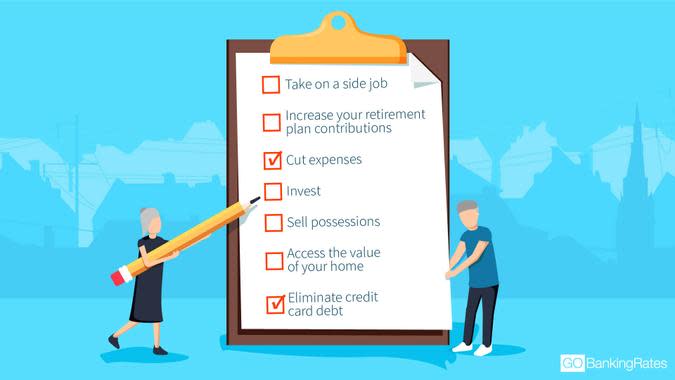Here’s Your Do-or-Die Retirement Plan If You Have Nothing Saved

If you’re concerned that you don’t have enough money saved for retirement yet, you’re not alone. More than half of Americans are not on their retirement savings target, and 34% are in the “red zone,” meaning that without major changes they will experience a sharp drop in lifestyle at retirement, according to a recent survey by Fidelity.
Housing Market 2023: The 10 Most Overpriced Housing Markets in the US — 5 Are in Florida
I’m a Real Estate Agent: Don’t Rent an Apartment If It Has Any of These 10 Problems
Although this might give you some solace, it won’t help you reach the approximately $164,000 in median retirement savings that Americans 65 years or older have. The good news is that with the right roadmap, you can still put away a decent sum of money to help you get by in your later years, even if you’re already approaching retirement age. Taking action now can pay big dividends when it comes to saving for the future.

Take on a Side Job
The number of people working a side job of some kind has risen dramatically over the last decade, a trend which has recently been turbocharged by the pandemic and runaway inflation. Recent surveys show that about 40% of Americans had some kind of side hustle last year — and the economics underlying this working revolution seem to be here to stay. A side hustle can be just about anything: consulting, freelancing, gig work, content creation and even making and selling your own crafts or artisanal products.
Retired But Want To Work? Try These 8 Jobs for Seniors That Require Little to No Experience
Social Security Cuts: These States Would Be Impacted Least

What You Can Save
Although consulting has historically been the domain of professionals and knowledge workers, and fields like writing and music have long been made up largely of freelance workers, advances in technology have brought a wide range of services and skills under the side hustle umbrella. Even if you can’t make artisan soap or craft handmade jewelry, you might be able to leverage your other skills into additional income. If you can pull in just $500 extra per month for 10 years before you retire, that’s another $60,000 toward your retirement.
Related: 27 Genius Things Retirees Should Do With Their Money Right Now

Increase Your Retirement Plan Contributions
The U.S. government understands the need for older Americans to increase their retirement savings, so it allows “catch-up” contributions to the retirement accounts of those ages 50 or older:
If you contribute to an IRA, the standard contribution limit is $6,500 for 2023. If you’re 50 or older, you can contribute an additional $1,000 to your IRA, for a total of $7,500.
Elective deferrals to a 401k, 457, 403b or the federal government’s Thrift Savings Plan are capped at $22,500 for 2023. However, people 50 and older are allowed to defer an additional $7,500 into their plans for a total of $30,000.

What You Can Save
It will be a challenge for most people to jump from no savings to the maximum contribution level overnight, but starting somewhere gives you a base to build on for the future.
For example, if you start contributing 5% of your salary into a retirement plan, try to increase that amount in small increments on a quarterly or even monthly basis. If you bump up your contributions over time, 1% per month for example, you might not even notice the difference from one month to the next.
But by the end of the year, you’ll have increased your contribution rate from 5% of your income to 17%, at which point your retirement savings will really start to accelerate.
To help you stick with your plan, set up automatic deductions from your paycheck or bank account. If you can reach that 17% savings level and you earn $50,000 per year, you’ll be tucking away $8,500 per year in your retirement plan, or $85,000 in total if you’re 10 years away from retirement.

Cut Expenses
Spending less than you make is obvious advice for savers of any age, but if you’re staring down retirement and you only have a small nest egg, you’ll need to go one step further. Beyond simply living within your means, you might need to sacrifice some luxuries or even simple wants to increase your retirement cushion.

What You Can Save
For those who are able to move, the best way to cut back on your expenses might be to relocate to a less expensive city. The more you can live without now, the more breathing room you’re providing for yourself in retirement. Moving doesn’t have to be your first step, though. Start small and cut out $25 in entertainment expenses each month. Over 10 years, that equals $3,000 in savings.

Invest
Your retirement nest egg will last longer if you invest part of it rather than just keeping it in a savings account. The national average savings account yield as of May 10th was a paltry 0.25% APY. With the inflation rate still at 4.93%, you’re actually losing purchasing power by keeping all your money in cash or savings.

What You Can Save
No matter how conservative an investor you are, to get your money to last throughout your retirement, you’ll need some exposure to growth investments like stocks. Earning even 5% on a $10,000 portfolio over 10 years would result in about $6,300 of additional funds at retirement.
Find Out: How Many Hours Can You Work and Still Collect Social Security?

Sell Possessions
You’ve likely acquired a number of items over your life that carry value, so take some time to ask yourself what purpose those things now serve. For example, if you have a piece of art or a beat-up classic car that you want to restore one day, they could be quite valuable if you sell them and put that money toward your retirement. Dig through those old boxes – the right collectible could make you millions. But if you don’t hit the jackpot, more mundane items can also be sources of cash.

What You Can Save
For example, if you still own any legacy media, like an old CD or DVD collection, you might be surprised at how much money you could earn selling them online. The same goes for furniture you no longer need or use, or other household items. If you have possessions that would not reduce your quality of life if they disappeared, consider liquidating them as part of your retirement planning strategy. Even just a thousand dollars in sales can help build out your retirement nest egg.

Access the Value of Your Home
Home ownership is often overlooked when it comes to retirement savings, even though it represents a big part of many Americans’ financial picture. According to FRED (Federal Reserve Economic Data), the nation’s homeownership rate was 66 percent as of the first quarter of 2023. With the median home value reaching $375,700 as of March 2023 according to the National Association of Realtors, many American families actually do have the assets to help them get through retirement. The question is, how can you tap the money tied up in your home while still having a place to live?
Social Security: No Matter Your Age, Do Not Claim Benefits Until You Reach This Milestone

What You Can Save
There are at least three ways you can unlock the value of your home and use it as a retirement funding strategy:
Home equity loan
Home equity line of credit
Reverse mortgage
The first two options let you borrow against your home equity in exchange for paying interest, just like a normal loan. A reverse mortgage is a special type of loan that essentially pays out a portion of your home equity in cash and doesn’t require repayment until you sell your home. All of these options have benefits and drawbacks, but they do provide you with a source of funds if you have no other options when it comes to retirement savings.

Eliminate Credit Card Debt
“Bad” debt, such as credit card debt, can significantly damage your long-term retirement savings plan. It’s best to pay it off as soon as possible. Although it might be counterintuitive to send money toward debt service when you are trying to accumulate money for retirement, in the long run, you’ll be better off.
The average credit card interest rate is a whopping 24.26%. This means that even without charging a single thing on your card going forward, the balance on that card will increase by nearly 25% every year if you don’t pay it off completely. If the card has a big balance, you could be looking at a hefty annual increase in your debt.

What You Can Save
If your debt is already crippling, there are additional options. Most unsecured debt, which includes credit card debt, can be discharged in bankruptcy. You can usually qualify for Chapter 7 bankruptcy if you fall under the median income for your state and are otherwise eligible. For example, the California median income as of May 2023 was $75,235.
You might also be able to negotiate your debt to a lower interest rate or even a lower balance — if you can make your case to your creditors. Either way, reducing or eliminating your credit card debt will go a long way toward making your retirement more secure. If you’re paying $500 per month in credit card debt, eliminating that payment could translate to an additional $6,000 per year in retirement savings.
Read: 10 Tips for Paying the Least Amount of Taxes in Retirement

Saving for Retirement Is Feasible, Even If You Start Late
Adding up the hypothetical numbers in this step-by-step guide results in retirement savings over 10 years of just over $155,000 — within reach of the national median for those 65 and older. And that doesn’t count whatever value of your house you want to tap.
Even though a disturbing percentage of Americans fear never being able to retire, now is not the time to despair. If you haven’t saved anything substantial yet, get started. In a decade, you’ll have a nice nest egg.
More From GOBankingRates
John Csiszar contributed to the reporting for this article.
This article originally appeared on GOBankingRates.com: Here’s Your Do-or-Die Retirement Plan If You Have Nothing Saved

 Yahoo Finance
Yahoo Finance 